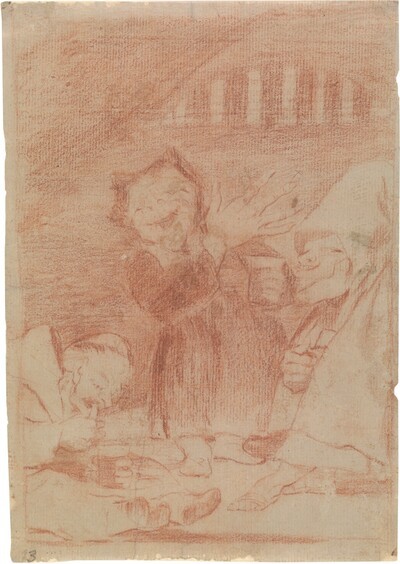- Cronología
- Ca. 1797 - 1799
- Dimensiones
- 217 x 152 mm
- Técnica y soporte
- Etching and burnished aquatint
- Reconocimiento de la autoría de Goya
- Undisputed work
- Ficha: realización/revisión
- 20 Aug 2013 / 29 May 2024
- Inventario
- 225
Duendecitos. (at the bottom)
49. (in the upper right-hand corner)
See Francisco de Goya y Lucientes, Painter.
A preparatory drawing of this engraving is in the Prado Museum.
Three grotesque goblins in friar's habits are holding glasses of wine. The one standing on the right of the engraving seems to belong to a barefoot order and, compared to the others, has a more taciturn and reserved attitude. The one in the centre gesticulates with a huge monstrous hand that does not correspond to his small size. He laughs with ease and reveals his battered, sharp-toothed dentition. The one on the left side of the print is seated on the floor and seems to be concentrating hard, looking at the glass he holds in one of his hands. The scene takes place in a dark, vaulted space, perhaps a cellar. At the top of the back of the room is a barred window.
With a fine aquatint Goya manages to create half-tones that contrast with the light streaming through the bars. The room is in semi-darkness and the painter did not wish to give priority to any of the three figures, who are treated equally.
The Manuscript of the Biblioteca Nacional describes this picture very well: "The real goblins of this world are the priests and friars, who eat and drink at our expense. The Church or the clergy has a sharp tooth and a monstrously long right hand to grasp; the barefoot friar, as the most gourmand, covers the glass of wine; but the footwear does not mess around; he pours soups in wine and trills happily".
In the second half of the 18th century, the word " goblin" was used to refer to the friars, so the artist could be interpreted as resuming his criticism of the clergy who, in this case, are drinking the wine they receive from the people's tithes. The painter questions the usefulness of the clergy, their role in a society that is obliged to support them in any case.
The deformed faces of the figures in the engraving are clearly reminiscent of the characters in The Family of the Rustic Bertoldo, an anonymous work from the late 18th or early 19th century. In these cases the heads are disproportionately large for the bodies, a deformity that is also seen in Little Goblins.
The plate is in rather poor condition, with the aquatint very worn ( National Chalcography, no. 220).
-
Goya. Gemälde Zeichnungen. Graphik. TapisserienKunsthalle BaselBasle1953from January 23th to April 12th 1953cat. 236
-
Goya y el espíritu de la IlustraciónMuseo Nacional del PradoMadrid1988from October 6th to December 18th 1988. Exhibited also at Museum of Fine Arts, Boston, January 18th to March 26th 1989; The Metropolitan Museum of Art, Nueva York, May 9th to July 16th 1989, Madrid curator Manuela B. Mena Marqués, scientific directors Alfonso E. Pérez Sánchez and Eleanor A. Sayrecat. 53
-
Goya. La década de Los CaprichosMadrid1992organized by Real Academia de Bellas Artes de San Fernando sponsored by Fundación Central Hispano, Madrid, consultant editor Nigel Glendinnig. From October 26th 1992 to January 10th 1993cat. 181
-
Francisco de GoyaMuseo d'Arte ModernaLugano1996exhibition celebrated from September 22nd to November 17th.cat. 49, p.76
-
Francisco Goya. Sein leben im spiegel der graphik. Fuendetodos 1746-1828 Bordeaux. 1746-1996Galerie KornfeldBern1996from November 21st 1996 to January 1997cat. 56
-
Goya artista de su tiempo y Goya artista únicoThe National Museum of Western ArtTokyo1999from December 1st to July 3th 1999cat. 113
-
Goya e la tradizione italianaFondazione Magnani RoccaMamiano di Traversetolo (Parma)2006consultant editors Fred Licht and Simona Tosini Pizzetti. From September 9th to December 3th 2006cat. 49, p.158
-
Goya. Opera graficaPinacoteca del Castello di San GiorgioLegnano2006exhibition celebrated from December 16th 2006 to April 1st 2007p.37
-
Goya e ItaliaMuseo de ZaragozaZaragoza2008organized by the Fundación Goya en Aragóna, consultant editor Joan Sureda Pons. From June 1st to September 15th 2008cat. 333
-
Goya et la modernitéPinacothèque de ParisParís2013from October 11st 2013 to March 16th 2014cat. 159
-
Goya engravings and lithographs, vol. I y II.OxfordBruno Cassirer1964p.122, cat. 84
-
Vie et ouvre de Francisco de GoyaParísOffice du livre1970p.182, cat. 549
-
Goya, la década de los caprichos: dibujos y aguafuertesMadridReal Academia de Bellas Artes de San Fernando1992pp.298-299, cat. 181
-
Catálogo de las estampas de Goya en la Biblioteca NacionalMadridMinisterio de Educación y Cultura, Biblioteca Nacional1996p.99, cat. 138
-
El libro de los caprichos: dos siglos de interpretaciones (1799-1999). Catálogo de los dibujos, pruebas de estado, láminas de cobre y estampas de la primera ediciónMadridMuseo Nacional del Prado1999pp.266-269
-
ParísPinacoteca de París2013p. 224
-
Goya. In the Norton Simon MuseumPasadenaNorton Simon Museum2016pp. 42-75

